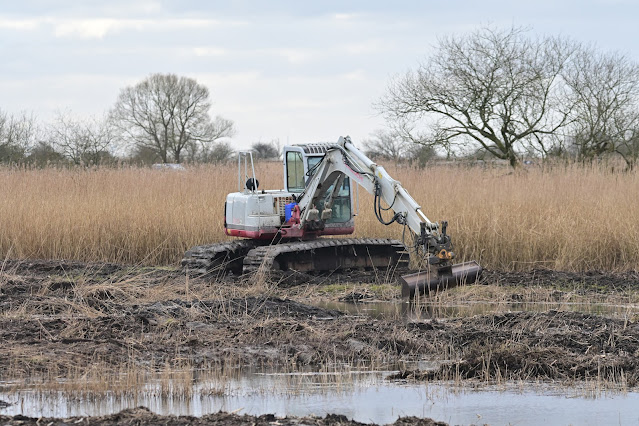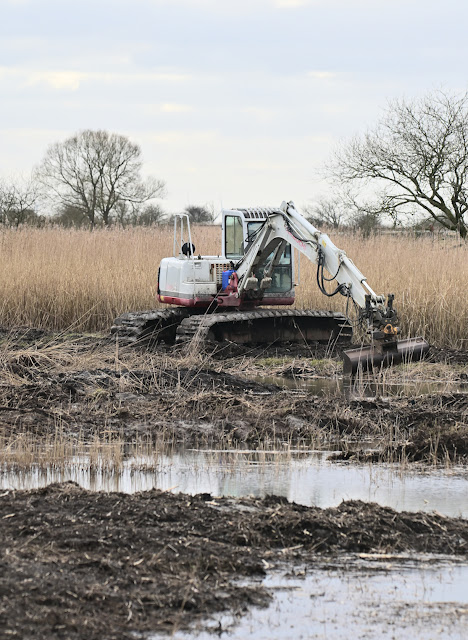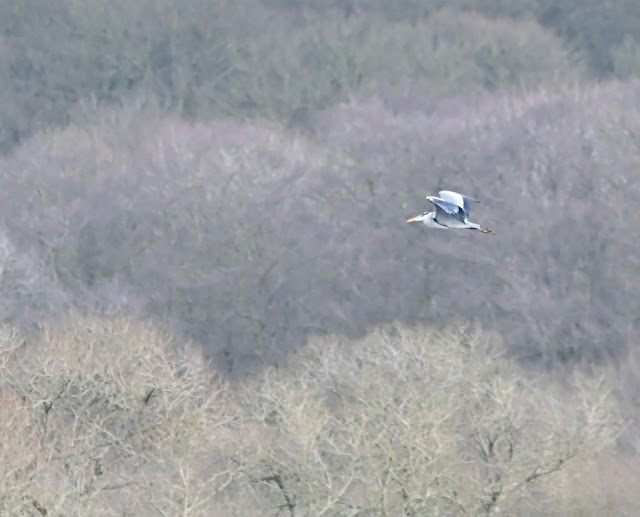The Safari isn't refering to the old motor car that our next door neighbour had many many years ago but the small camelflagged marshland bird. We meant the latest 1960's incarnation of the vehicle - we're not THAT old!
We headed north with CR, no Southsiders today as they were both otherwise engaged. Our destination was the marvelous Leighton Moss reserve where as usual we had high hopes for some great sightings. Normally we go straight to the main reserve but today we had an early diversion to the saltmarsh for a change, the light is better for viewing there in the morning so really we should call in there first much more often.
At the Allen Hide the water level was much higher than is best for the birds and so there was only a small number of ducks scattered about, mostly in the farthest corners of the pool. Shoveler, Shelduck, Gadwall and Wigeon made up the bulk of what was on offer. The nearest little island had the only 'in range' birds, Shoveler and Gadwall and after inspecting the left hand corner a couple of carefully secreted Snipe. With not a lot on offer we soon got up to leave to try our luck at the Eric Morecambe hide but as we did so the birder at the other end of the hide asked if we'd spotted the Jack Snipe - which we hadn't. It could have obscured from our view point by the intervening vegetation or more likely we just didn't notice it further back from the water's edge on the top of the island. He kindly let us have a look through his scope and once we'd got our bearings we fired a few shots off but it was always mostly obscurred, we did get to watch it doing its 'sewing machine' bobbing 'dance' which is always good to see. Can you find it in the pic below - the best shot we got. Huge thanks to the birder who put us onto it, a great bird for our Challenge as they are very rarely easy to get a pic of.

A rather rubbish side on shot was also had, sadly we never did see its face. #77 for our Challenge.

At the Eric Morecambe Hide again everything on offer was too distant, due to the high water levels, apart from this Curlew which was on the bund between the two pools. #78
A scan of the water ridden marshes, we think the recent high tides had been high enough to wash right across the marsh, gave us a couple
Little Egrets, a skein of a couple of hundred
Pink Footed Geese landed miles away and a check of all the fence posts didn't give us a hoped for
Merlin, or any other bird of prey for that matter. Again in the absence of anything close we didn't stop too long before deciding to head to Lillian's hide on the main reserve. On the way to the hide we passed a very empty feeding station, all the feeders had been taken in consequently no birds were about. The reason for the lack of food is the risk of disease particularly the finches and the RSPB wanting make feeding the birds as safe as possible for them. They are reviewing the advice they give us about feeding the birds and the feeding products they offer for sale. There'll be more detailed information from the RSPB during the coming year. In the meantime the best thing you can do is make sure your feeders are cleaned at least weekly.
At Lillian's Hide there was some significant disturbance going on. A very interesting piece of kit was out on the water cutting reeds. If you remember from our previous blog we mentioned that big animals provided a habitat mangement service at the landscape scale in the very old days and nowadays we almost always have to use proxy domesticated, but hardy, animals for this job although we doubt if the now extinct Aurochs nor, still with us but sadly not in Britian, Moose would be able to make the inroads into the reedbed like this machine can. We assume it's making deeper channels through the reeds to allow fish to penetrate further into the reedbed where Bitterns can catch them without coming out into more open areas which they don't particularly like to do.
The machine had pushed the waterfowl into the farthest reaches of the pool and the great majority of the waterfowl were
Coots which have started to get uppity as the days are no lengthening nicely towards spring.
All very dynamic but not the Ring Necked Duck we wanting to find. Looking around at what else was on offer we soon found a couple of Marsh Harriers wafting around above the reeds.
A Heron broke cover making it Egrets 2 - 1 Herons, what would today's final score be?
The Heron may have been flushed by the reed cutting machine, it was over that way.
We watched the Marsh Harriers for a while and couldn't help but notice beneath them a large muddy mound that the reed cutting machine had dumped away to our right.
Now to our mind this isn't ideal. It will rot down to a much smaller size but will always be a little hump within the reedbed where a Willow tree/bush is likely to take hold which will happen sooner ot later, as you can see there's just such a thing close by. A small amount of Willow trees scattered through the reedbed isn't too much of a problem and is going to beneficial to some of the reedbeds inhabitants but are a problem for the specialists like the Bitterns and Bearded Tits if there are too many and they become to large. The issue is how on earth do you get huge quantities of 'waste' out of the reedbed and where do you put it when you have - do you keep it on site, if so doing what, perhaps making compost but for what exactly, or remove it off site at great cost no doubt. The dilemas of being a reserve manager.
Anyway we moved on to Grisedale hide where the most exiting thing on the pool wasn't a living thing but another machine - this was becoming a good day!
It had been scraping channels and creating low islands around the pool.
Again you can see large mounds of excavated material, we're sure they won't be left like that. The bund on the righthand side is used as a pathway by the Red Deer, and no doubt other mammals, when they are frequenting the reedbed. We're not sure that if we were the reserve manager we'd pull out those two Willow bushes to the right of the mounds, hmmm thinking about it we probably would, there's quite a few smaller ones coming up around the pool to replace them.
There wasn't much on the pool but once again
Marsh Harriers drifted too and fro in the distance.
Including our first male of the day
Moving on to Tim Jackson Hide we'd almost reached the door when a small bird shot low across the path and called as it disappeared behind a large tree trunk, a
Treecreeper. It was followed almost immediately after by a second, this one didn't disappear but began to work its way into the top of the tree it landed on.
However we soon lost it when it scurried round the back of a thick branch. Moments later it, or the first one, flew down low to land on the bole of a tree on the other side of the path. #79
Where it found what looks like a fly pupa.
Or maybe a moth chrysalis.
Once in the hide we sat down, opened the windows, got our baggin out of our rucksack and opened a packet of crsips the loud rustling of which flushed a few
Snipe from right beneath us. After a good scoff we had a further search for more snipe after seeing one briefly not too far to the left but it proved too good at hiding. Several minutes later when we'd just about given up on it it pottered into view.
Time to move on again so we retraced our steps for another quick look from Lillian's Hide on the way to the Causeway Hide where again the water level was a little higher than normal.
To our consternation almost all the birds were distant with 'just' a few
Coots and
Gadwall closer or not far beyond the island of
Cormorants some of which are now sporting their breeding 'whites'. With the
Ring Necked Duck not being on Lillian's pool it was more than likely on this one but we could only really see half way down this large expance of water with the bins and although there was a small mixed flock of
Goldeneyes,
Pochards and
Gadwall at 'the gap' it wasn't with them. There were a lot more birds,
Coot and
Tufted Duck mostly from what we could make out without a telescope right at the far end of the pool but without said scope there was no way we could pick out our American friend at that range.
Probably the most 'unusual' bird on the pool was this
Great Crested Grebe. Yep that was as good as it got. But while getting pics of this bird we're pretty sure we caught a
Bittern out of the corner of our eye flying low across the 'gap' in the distance.
Until a
Robin came in to the hide through one of the open windows. With no extra food on offer, feeding the birds along the trails where you'd be mugged by
Robins has been stopped for a while and the feeding station recently out of commision the poor little chap must have been starving. Inside the hide there are pie and sandwich crumbs to be had and maybe if it was lucky cake crumbs too - this little chap knew which side his/her bread was buttered!

We left the Causeway Hide and headed back to Lillian's Hide listening for
Siskins in the tall
Alder trees on the way. Not a tinkle, the trees were soundless and there was no flitting going on in the uppermost branches. A litle further on we stopped suddenly when we heard a short snatch of quite musical song we didn't recognise. Standing still for a couple of minutes we heard it again and the singer revealed itself to be a
Marsh Tit. Of course we're very familiar with their 'pitchooo' call but had we not seen the bird singing would have been flummoxed as to what was singing.
We were relieved it showed itself and stayed still in the dense shrubbery long enough for us to get a pic of now the feeding station is no more as that was by far the best place to watch for them. #80 for our Challenge. Sitting comfortably in Lillian's Hide we scanned the waterfowl for the
Ring Necked Duck but again without success.The reed cutting machine had gone but the
Marsh Harriers were still on the prowl.
As you've probably noticed the light was pretty grim today and our subjects mostly distant so our pics aren't the best but by early afternoon the sun did try to venture out from behind the clouds from time to time...and we had some much closer subjects to point the lens at.

We even took a pic of a pair of Gadwall, a species we'd sort of promised ourselves not to get any pics of today unless they were exhibiting some unusual behaviour as we have a plethora of them already. a fly-by isn't that unusual but hey what the heck we couldn't resist.
Maybe we should have the same philosophy about Marsh Harriers, we've got tons of poor distant pics of them in grotty light against dull backgrounds; it must surely be time to be far more selective with the shutter button.
We just can't resist! Now the bits of sunshine had got the drakes in a small group of
Teal over-excited and they began to do some coutship display albeit rather half-heartedly.
Following the right male was an issue, we'd lock on to one and nine times out of ten it would be one of his competitors that threw the shapes invariably just out of frame.
All this excitement got one of them in a bit of a flap.
Go on - show us your scapulars!
Meanwhile a
Great White Egret appeared in the distance. #81.
Followed soon after by another
Heron.
The score now was Egrets 3 - 2 Herons.
Close to the displaying Teal were a trio of Snipe quietly feeding not far to our left.
Slowly they began to inch closer our way.
Across the pool a female Marsh Harrier landed on the edge of the reed bed and sat there for several minutes.
When she took to the air we couldn't resist taking more rubbishy shots.
Back to the
Snipe which had crept a little closer now.
Fabulously patterned birds aren't they.
After a while two of them swam, one at a time, from the little reedy island to the reedy 'mainland.
While the third took a slightly different route and was able to walk across.
At the far side of the reserve another
Great White Egret appeared and then it was followed by a second a minute or so later. Another day and another thrashing for Team Heron; Egrets 6 - 2 Herons.
Suddenly there was a deep throbbing chugg chugg chugg chugg noisde coming from over the hill in the background, you could feel the throb in your guts then this huge Chinook helicopter came flying right over us. We expecgted a scattering of waterfowl but they all totally ignored it, even the
Snipe didn't bat an eyelid.

The sun came out again and the
Snipe continued to wander slowly in our direction. We filled our boots!
This one facing away showed nicely how they can see over their shoulder at the same time as looking down their long bill. Very handy for spotting danger when you've got your face down in the mud.
And just a couple more to finish off this post - great aren't they, and all the better for having some sunshine on them.
Thank you Snipe for brightening what might otherwise have been a fairly dull day - and we didn't see any mammals at all.
Where to next? We'll be out on safari on the Southside again next week.
In the meantime let us know creeping round the trees in your outback.



























































No comments:
Post a Comment